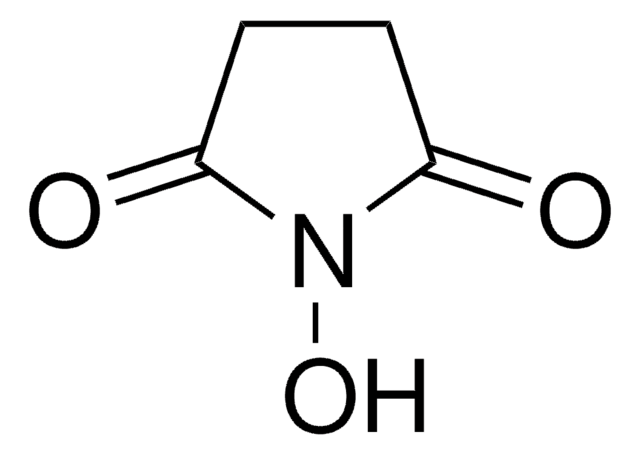371890
3-Aminopropyl(diethoxy)methylsilane
97%
동의어(들):
3-(Diethoxymethylsilyl)propylamine, 3-Aminopropyl-methyl-diethoxysilane
로그인조직 및 계약 가격 보기
모든 사진(1)
About This Item
Linear Formula:
CH3Si(OC2H5)2(CH2)3NH2
CAS Number:
Molecular Weight:
191.34
Beilstein:
1744264
EC Number:
MDL number:
UNSPSC 코드:
12352103
PubChem Substance ID:
NACRES:
NA.23
추천 제품
Quality Level
분석
97%
양식
liquid
refractive index
n20/D 1.426 (lit.)
bp
85-88 °C/8 mmHg (lit.)
density
0.916 g/mL at 25 °C (lit.)
SMILES string
CCO[Si](C)(CCCN)OCC
InChI
1S/C8H21NO2Si/c1-4-10-12(3,11-5-2)8-6-7-9/h4-9H2,1-3H3
InChI key
HXLAEGYMDGUSBD-UHFFFAOYSA-N
유사한 제품을 찾으십니까? 방문 제품 비교 안내
애플리케이션
- Amino Surface Modification and Fluorescent Labelling of Porous Hollow Organosilica Particles: Optimization and Characterization.: This study showcases the effectiveness of 3-Aminopropyl(diethoxy)methylsilane in modifying the surface properties of porous hollow organosilica particles, enhancing their application in biosensing and drug delivery systems. The modification process improves particle stability and functionality, demonstrating the compound′s utility in high-performance biomedical applications (Al-Khafaji et al., 2022).
- Superelastic Multifunctional Aminosilane-Crosslinked Graphene Aerogels for High Thermal Insulation, Three-Component Separation, and Strain/Pressure-Sensing Arrays.: This research highlights the role of 3-Aminopropyl(diethoxy)methylsilane in producing graphene aerogels with exceptional properties such as elasticity, durability, and multi-functionality. These aerogels are promising for thermal insulation, filtration, and as sensors in automotive and aerospace industries, showcasing the compound′s broad potential in advanced material applications (Zu et al., 2019).
- Improving the Gas-Separation Properties of PVAc-Zeolite 4A Mixed-Matrix Membranes through Nano-Sizing and Silanation of the Zeolite.: Utilizing 3-Aminopropyl(diethoxy)methylsilane for the surface modification of Zeolite 4A, this study enhances the gas-separation efficiency of PVAc-zeolite mixed-matrix membranes. The research addresses significant challenges in membrane-based separation technologies, particularly in the purification processes critical for environmental and industrial applications (Esmaeili et al., 2019).
신호어
Danger
유해 및 위험 성명서
Hazard Classifications
Skin Corr. 1B
Storage Class Code
8A - Combustible corrosive hazardous materials
WGK
WGK 3
Flash Point (°F)
185.0 °F - closed cup
Flash Point (°C)
85 °C - closed cup
개인 보호 장비
Faceshields, Gloves, Goggles, type ABEK (EN14387) respirator filter
이미 열람한 고객
Xuexue Xu et al.
Talanta, 205, 120089-120089 (2019-08-28)
We propose a promising capillary immunosensor by combining porous-layer surface modification of an open-tubular capillary and streptavidin-biotin-peroxidase nano-complex signal amplification of chemiluminescence read-out. The immunosensor, namely Porous Layer Open Tubular-Signal Amplification (PLOT-SA) sensor, is successfully applied for ultra-sensitive sensing of
Qishu Qu et al.
Electrophoresis, 37(15-16), 2175-2180 (2016-05-14)
In this work, open-tubular capillary column coated with zeolite imidazolate framework-8 (ZIF-8) nanocrystals was prepared by a layer-by-layer method. The coating was formed by growing ZIF-8 nanocrystals on either bare fused silica capillary wall or the capillary column premodified with
Huifang Liu et al.
Molecules (Basel, Switzerland), 24(7) (2019-04-17)
Infectious diseases, especially pathogenic infections, are a growing threat to public health worldwide. Since pathogenic bacteria usually exist in complex matrices at very low concentrations, the development of technology for rapid, convenient, and biocompatible sample enrichment is essential for sensitive
Xingda Song et al.
Analytica chimica acta, 1043, 1-10 (2018-11-06)
We proposed an innovative surface modification-mediated porous layer open tubular (PLOT) capillary, which was modified via an in situ biphasic reaction. This capillary comprised three-dimensional homogeneous and porous structures, which could increase the surface-area-to-volume ratio for antibody immobilization. The PLOT
Qishu Qu et al.
Journal of chromatography. A, 1399, 25-31 (2015-05-09)
A simple coating procedure employing a multilayer-by-multilayer process to modify the inner surface of bare fused-silica capillaries with silica nanoparticles was established. The silica nanoparticles were adsorbed onto the capillary wall via a strong electrostatic interaction between amino functional groups
문서
Mesoporous Oxides and Their Applications to Hydrogen Storage
자사의 과학자팀은 생명 과학, 재료 과학, 화학 합성, 크로마토그래피, 분석 및 기타 많은 영역을 포함한 모든 과학 분야에 경험이 있습니다..
고객지원팀으로 연락바랍니다.


![N-[3-(Trimethoxysilyl)propyl]ethylenediamine 97%](/deepweb/assets/sigmaaldrich/product/structures/149/508/f87a9a89-f138-4c5e-9fe0-6561914241c3/640/f87a9a89-f138-4c5e-9fe0-6561914241c3.png)






